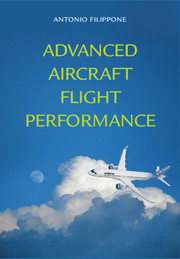Book contents
- Frontmatter
- Contents
- Tables
- Preface
- Nomenclature
- Technology Warning
- 1 Prolegomena
- 2 Aircraft Models
- 3 Weight and Balance Performance
- 4 Aerodynamic Performance
- 5 Engine Performance
- 6 Propeller Performance
- 7 Airplane Trim
- 8 Flight Envelopes
- 9 Take-Off and Field Performance
- 10 Climb Performance
- 11 Descent and Landing Performance
- 12 Cruise Performance
- 13 Manoeuvre Performance
- 14 Thermo-Structural Performance
- 15 Mission Analysis
- 16 Aircraft Noise: Noise Sources
- 17 Aircraft Noise: Propagation
- 18 Aircraft Noise: Flight Trajectories
- 19 Environmental Performance
- 20 Epilogue
- Appendix A Gulfstream G-550
- Appendix B Certified Aircraft Noise Data
- Appendix C Options for the FLIGHT Program
- Index
- References
18 - Aircraft Noise: Flight Trajectories
Published online by Cambridge University Press: 05 January 2013
- Frontmatter
- Contents
- Tables
- Preface
- Nomenclature
- Technology Warning
- 1 Prolegomena
- 2 Aircraft Models
- 3 Weight and Balance Performance
- 4 Aerodynamic Performance
- 5 Engine Performance
- 6 Propeller Performance
- 7 Airplane Trim
- 8 Flight Envelopes
- 9 Take-Off and Field Performance
- 10 Climb Performance
- 11 Descent and Landing Performance
- 12 Cruise Performance
- 13 Manoeuvre Performance
- 14 Thermo-Structural Performance
- 15 Mission Analysis
- 16 Aircraft Noise: Noise Sources
- 17 Aircraft Noise: Propagation
- 18 Aircraft Noise: Flight Trajectories
- 19 Environmental Performance
- 20 Epilogue
- Appendix A Gulfstream G-550
- Appendix B Certified Aircraft Noise Data
- Appendix C Options for the FLIGHT Program
- Index
- References
Summary
Overview
In Chapter 16 we discussed various methods that can be used for the rapid prediction of aircraft-noise sources. In Chapter 17 we described the effects of atmospheric propagation, interference and scattering. In this chapter we deal with aircraft-noise trajectories. In particular, we discuss noise certification (§ 18.1) and noise-abatement procedures (§ 18.2). The implementation of the various sub-models requires a flight mechanics integration (§ 18.3) and a data-handling structure, to process the large matrices produced by several noise sources. A noise sensitivity analysis is presented (§ 18.4) to show the relative importance of the various noise sources to explain the most useful strategies for noise reduction. We discuss two case studies: the ICAO/FAR noise trajectories of a jet-powered aircraft (§ 18.5) and the ICAO/FAR noise trajectories of a turboprop aircraft (§ 18.6). We also present a number of noise applications, such as steep descent and wind effects (§ 18.7). To complete our discussion of the noise modelling, we provide an example of verification with flight data (§ 18.8). The last item of investigation is the noise footprint around the airfield (§ 18.9).
KEY CONCEPTS: Aircraft Noise Certification, Noise-Abatement Procedures, Flight- Mechanics Integration, Noise Sensitivity, Noise Trajectories, Wind Effects, Footprints, Sonic Boom.
Aircraft Noise Certification
Unlike a Beethoven symphony, aircraft noise is not welcome music to the ear. The second movement of the Ninth Symphony does not start with a landing-gear deployment. Communities that live near large airports know this fact rather well. In fact, they have been making noise on their own by voicing their concern.
- Type
- Chapter
- Information
- Advanced Aircraft Flight Performance , pp. 553 - 588Publisher: Cambridge University PressPrint publication year: 2012



